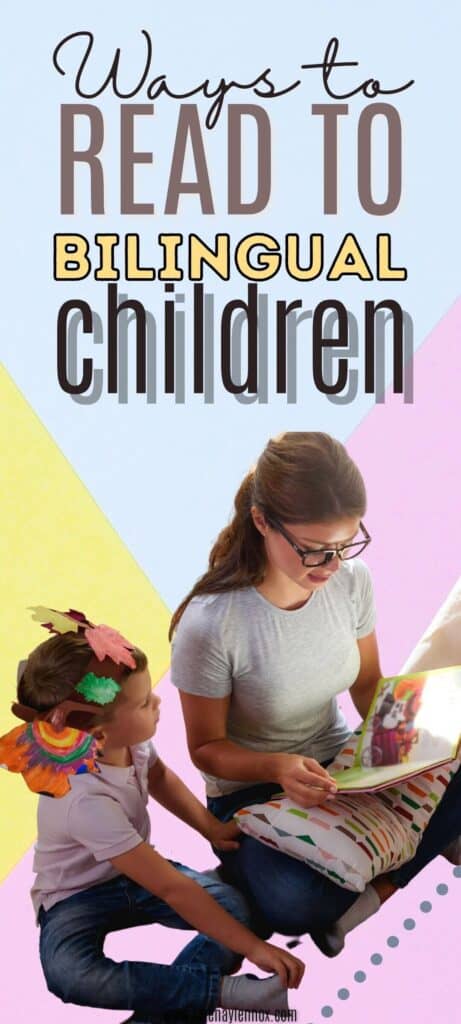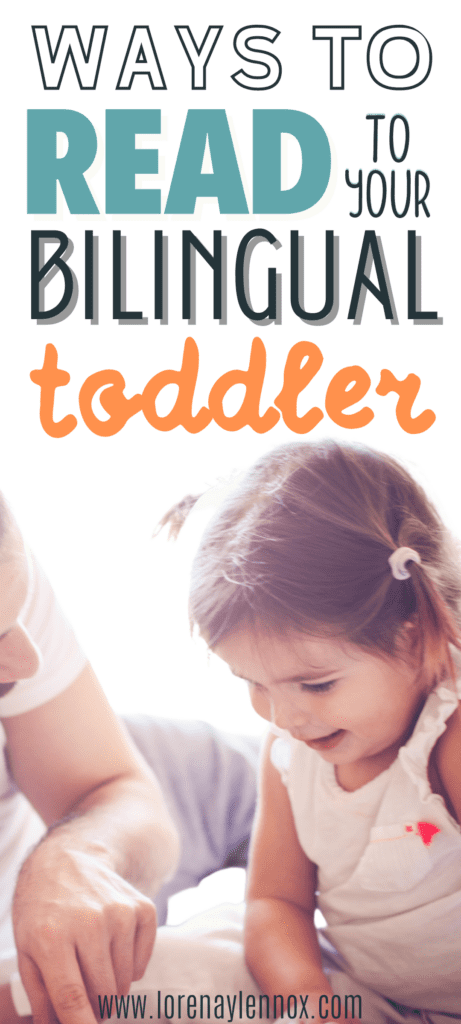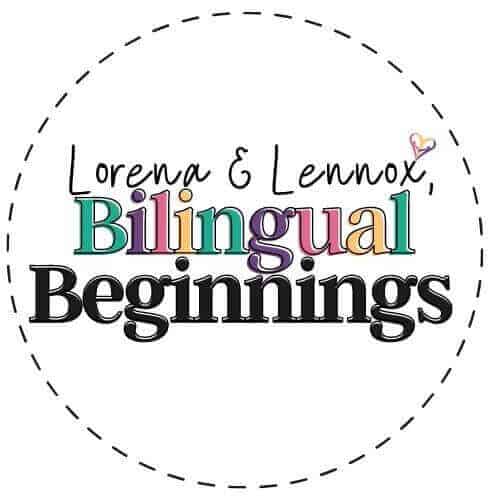Reading is undeniably one of the most effective ways to foster language learning and expand vocabulary, whether you’re raising a monolingual or multilingual child.
In my recent post outlining nine strategies for teaching my toddler Spanish as a nonnative speaker, I emphasized the importance of reading books, and lots of them.
If you’re feeling inspired to rush out and stock up on books in the second language for your bilingual child, that’s fantastic!
However, before you splurge on expensive children’s books—because let’s be honest, they can be pricey—I want to share some valuable tips on how to engage bilingual children in the minority language even without access to books in that language.

1. Be consistent
Start reading to your bilingual child as soon as possible as much as possible.
Create a daily routine where at least once a day, you are making time for a reading session.
What’s your family language plan for raising your bilingual child? If you don’t have one, now is a good time to choose your plan and get consistent in your bilingual parenting journey! Check out four popular plans below!
- Minority Language at Home (MLAH): A Bilingual Parenting Method
- One Person One Language (OPOL): A Bilingual Parenting Method
- Time and Place: A Bilingual Parenting Method
- Mixed Language Strategy: A Common Bilingual Parenting Method
2. Read aloud
Reading aloud in the target language will create a bonding time between the parent and child. Furthermore, it will form a positive relationship with books and reading.
Your toddler may gravitate towards the same book each time, but keep in mind that repetition is a useful technique for language learning. Eventually, your child will be versing the book back to you.
In the book Maximize Your Child’s Bilingual Ability, Author Adam Beck refers to this experience as a “home run book,” a term coined by Jim Trelease. By this, his means that creating a positive experience with a book can result in a lifelong reader.
3. Don’t worry about having a huge library in the target language.
When I started reading to Lennox as a baby, I used to get frustrated at my limited Spanish library.
We had a decent selection of donated and gifted books in English, but I could count one hand the number of Spanish children’s books we owned.
I was constantly browsing on Amazon and placing Spanish books in my cart, only to save them for later because they were not something we absolutely needed.
That’s when I decided to repurpose our children’s books in English by doing the following:
I would read each book myself first to find vocabulary that I did not know in Spanish. I would find their meaning and jot them down on a piece of paper in both Spanish and English. This helps my adult brain with memorization, and if you read my post about ways that I learned Spanish outside of the classroom, you know I am a nerd for this.
Once I knew all of the words, I would:
- If the books were short enough, translate them myself. Over time each book became more natural to translate.
- Paraphrase what the book is saying or make up my own version in the target language.
- Or, use it as a time to invite Lennox to use the target language to talk about what is happening, or what he can find in the book (colors, shapes, emotions, etc.)
Looking for books in Spanish? Here are some thematic book lists:
- 15 Spanish Fall Books To Read This Otoño
- 25 Spanish Picture Books To Read This Christmas
- 23 Spanish Children’s Picture Books To Learn the Alphabet
- 30 + Books in Spanish About Emotions
- 17 Ocean Books in Spanish for Kids
- 20 Back-to-School Picture Books in Spanish
- 23 Picture Books About Colors in Spanish
- 12 Zoo Animal Picture Books in Spanish
4. Visit your local library
I have found some of the best children’s books in Spanish at my local library. You might be surprised at what hidden treasures you might find at yours!
5. Turn your book into a song
If you have a busy-bodied toddler like myself, reading might not be their favorite activity, unless you can turn it into a way for them to get up a dance to a beat.
For the longest time, Lennox protested books, until I turned his favorite baby book, Díos te bendiga y buenas noches, into a song with a beat. I took its beautiful rhyming verse and created a tune that stuck with Lennox throughout the days and made him anticipate book time.
Related: Learn Spanish Through Music With These Artists
6. Find the proper books in the target language
I have come across way too many children’s books in Spanish with very poor English to Spanish translations.
To avoid this, I try to visit my local library or book stores to search out well-written, educational, and entertaining children’s books in Spanish. I keep a written list of books I love and add it to a wish list for family members and friends to gift Lennox for holidays and birthdays.
Related: Thematic picture books in Spanish for kids
I hope these tips are useful to you and your bilingual little. They sure have worked to create a fun reading routine in our household.
If this post is right up your alley, subscribe below so you can receive all of our future book recommendations and bilingual parenting tips!
Related posts you might enjoy:
- The Best Interactive Bilingual Spanish Toys for Babies and Toddlers
- Minority Language at Home Bilingual Parenting Approach
- 10 Must- Know Misconceptions About Raising Bilingual Children

